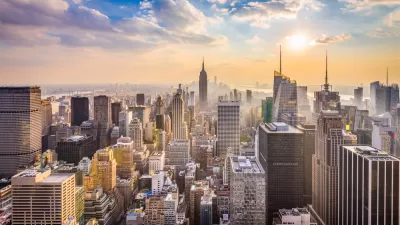Despite fears of a mass exodus, most cities are seeing only modest population losses, with the majority of movers staying in the same metro area.

Rather than the "urban exodus" that many analysts feared the pandemic would precipitate, write Marie Patino, Aaron Kessler, and Sarah Holder for Bloomberg CityLab, "perhaps it’s more of an urban shuffle."
As research about the last year begins to crystallize, "data shows most people who did move stayed close to where they came from." According to the authors, "[i]n the country’s 50 most populous cities, 84% of the moves were to somewhere within the perimeter of the central metro area, down just slightly from pre-pandemic levels."
New York City and San Francisco saw more dramatic changes. "The regions around San Francisco and San Jose, two of the country’s most expensive housing markets, saw the rates of permanent moves increase the most, by more than 23% and 17% respectively, compared to 3% nationally." New York City "saw the greatest loss in net moves into the city over the past year" as Manhattan residents relocated to outer boroughs, nearby suburbs like Long Island, and outlying areas like the Bridgeport-Stamford-Norwalk region of Connecticut, less than 60 miles from the city. Some smaller cities are seizing on the opportunity with incentive programs designed to attract remote workers.
But the "release valve" created by the sudden boom in remote work "is not available to the majority of American workers, who can’t work remotely, particularly essential workers and low-wage workers." Knowing the remote work boom may not last, cities like Stockton, "a sizable majority-nonwhite city that’s been deemed the most diverse in America," are focusing instead on attracting companies and job opportunities for existing residents.
FULL STORY: More Americans Are Leaving Cities, But Don’t Call It an Urban Exodus

Alabama: Trump Terminates Settlements for Black Communities Harmed By Raw Sewage
Trump deemed the landmark civil rights agreement “illegal DEI and environmental justice policy.”

Study: Maui’s Plan to Convert Vacation Rentals to Long-Term Housing Could Cause Nearly $1 Billion Economic Loss
The plan would reduce visitor accommodation by 25% resulting in 1,900 jobs lost.

Planetizen Federal Action Tracker
A weekly monitor of how Trump’s orders and actions are impacting planners and planning in America.

Waymo Gets Permission to Map SF’s Market Street
If allowed to operate on the traffic-restricted street, Waymo’s autonomous taxis would have a leg up over ride-hailing competitors — and counter the city’s efforts to grow bike and pedestrian on the thoroughfare.

Parklet Symposium Highlights the Success of Shared Spaces
Parklets got a boost during the Covid-19 pandemic, when the concept was translated to outdoor dining programs that offered restaurants a lifeline during the shutdown.

Federal Homelessness Agency Places Entire Staff on Leave
The U.S. Interagency Council on Homelessness is the only federal agency dedicated to preventing and ending homelessness.
Urban Design for Planners 1: Software Tools
This six-course series explores essential urban design concepts using open source software and equips planners with the tools they need to participate fully in the urban design process.
Planning for Universal Design
Learn the tools for implementing Universal Design in planning regulations.
Caltrans
Smith Gee Studio
Institute for Housing and Urban Development Studies (IHS)
City of Grandview
Harvard GSD Executive Education
Toledo-Lucas County Plan Commissions
Salt Lake City
NYU Wagner Graduate School of Public Service





























